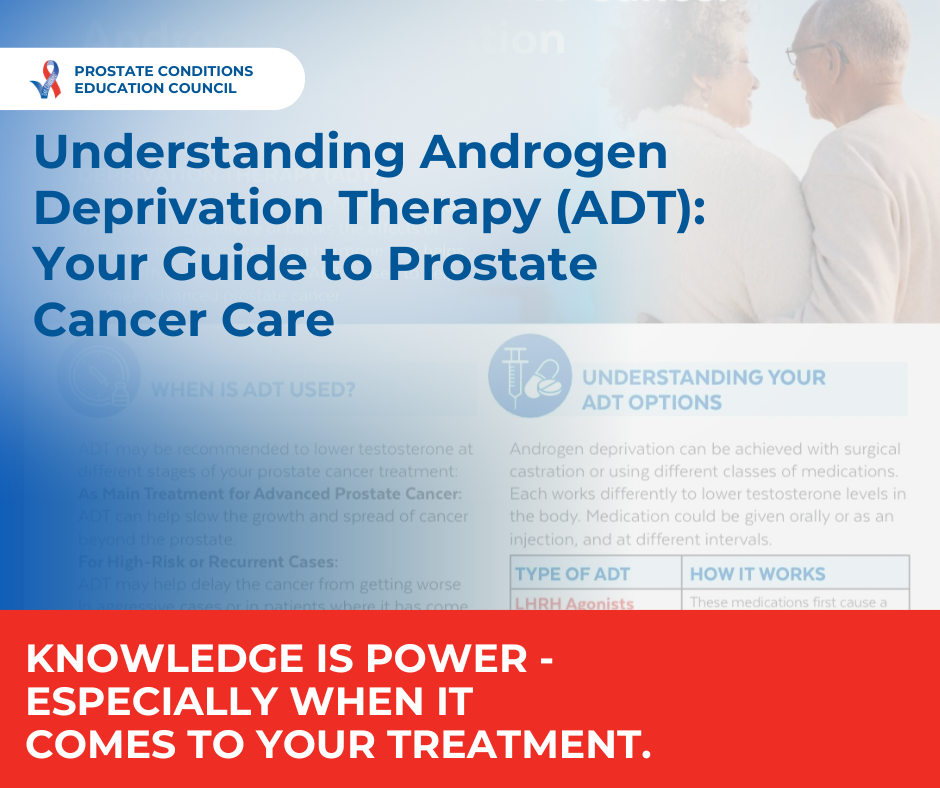Prostate cancer cells need fuel to grow and survive. The male hormone testosterone is the main fuel for prostate cancer cell growth, which makes it a common target for therapeutic intervention. Hormone therapy is also referred to as androgen deprivation therapy (ADT) because testosterone is a type of androgen. The goal of ADT is to deprive cancer cells the testosterone they use to grow. This can be accomplished by reducing testosterone levels or by preventing the actions of testosterone. ADT often slows tumor growth and may shrink prostate tumors.
Hormonal therapy can be used before radiation therapy or surgery to shrink the prostate cancer tumor, in conjunction with radiation as an initial treatment or in cases of recurrent disease. There are two types of hormone therapies.
Treatments that reduce testosterone levels:
Bilateral Orchiectomy (surgical castration):
As the majority of testosterone is produced by the testicles, bilateral orchiectomy, or the surgical removal of both testicles, results in much lower testosterone levels in the body.
Lutenizing hormone-releasing hormone (LH-RH) analogs:
LH-RH analogs shut down testosterone production by the testicles. LH-RH analogs can reduce testosterone production to castration levels. LH-RH analogs are injected or implanted under the skin. Below is a list of some LH-RH therapies:
- Lupron (Leuprolide)
- Eligard (Leuprolide)
- Zoladex (Goserelin)
- Trelstar (Triptorelin)
- Vantas (Histrelin)
- Suprefact (Buserelin)
LH-RH antagonists:
LH-RH antagonists also shut down testosterone production by the testicles. Similar to LH-RH analogs, LH-RH antagonists can reduce testosterone production to castration levels. LH-RH antagonists are given as monthly injections and are often used to treat advanced prostate cancer. Below is a list of LH-RH antagonist therapies:
- Firmagon (Degarelix)
Androgen Synthesis Inhibitors:
Small amounts of testosterone are produced outside of the testicles. For example, testosterone can be made by the adrenal gland and is sometimes even made by the prostate cancer cells themselves. Androgen synthesis inhibitors can block the production of androgens, like testosterone, from being made throughout the body. These drugs can interfere with the production of other hormones and therefore are often prescribed with a corticosteroid such as prednisone. Below is a list of androgen synthesis inhibitor therapies:
- Zytiga (Abiraterone)
- Nizoral (Ketoconazole)
Treatments that block actions of testosterone:
Antiandrogen Therapies:
Androgens work by binding to a protein called an androgen receptor. Antiandrogen therapies block this receptor from functioning, which prevents androgens from promoting the growth and survival of prostate cancer cells. These drugs are typically taken daily as pills and are often taken alongside another form of ADT. Below is a list of antiandrogen therapies:
- Erleada (Apalutamide)
- Nubeqa (Darolutamide)
- Eulexin (Flutamide)
- Casodex (Bicalutamide)
- Nilutamide (Nilandron)
- Xtandi (Enzalutamide)
Side Effects:
There are many factors that contribute to the risk of side effects from hormone therapy, including age, fitness level, and duration of treatment. However, many side effects of hormone therapy can be prevented or treated. Some symptoms of hormone therapy are:
- Reduced or absent sexual desire
- Erectile dysfunction
- Shrinkage of testicles and penis
- Hot flashes
- Breast tenderness and growth of breast tissue
- Osteoporosis
- Anemia
- Decreased mental sharpness
- Loss of muscle mass
- Weight gain
- Fatigue
- Nausea and diarrhea
- Increased cholesterol levels
- Depression


